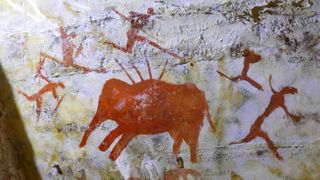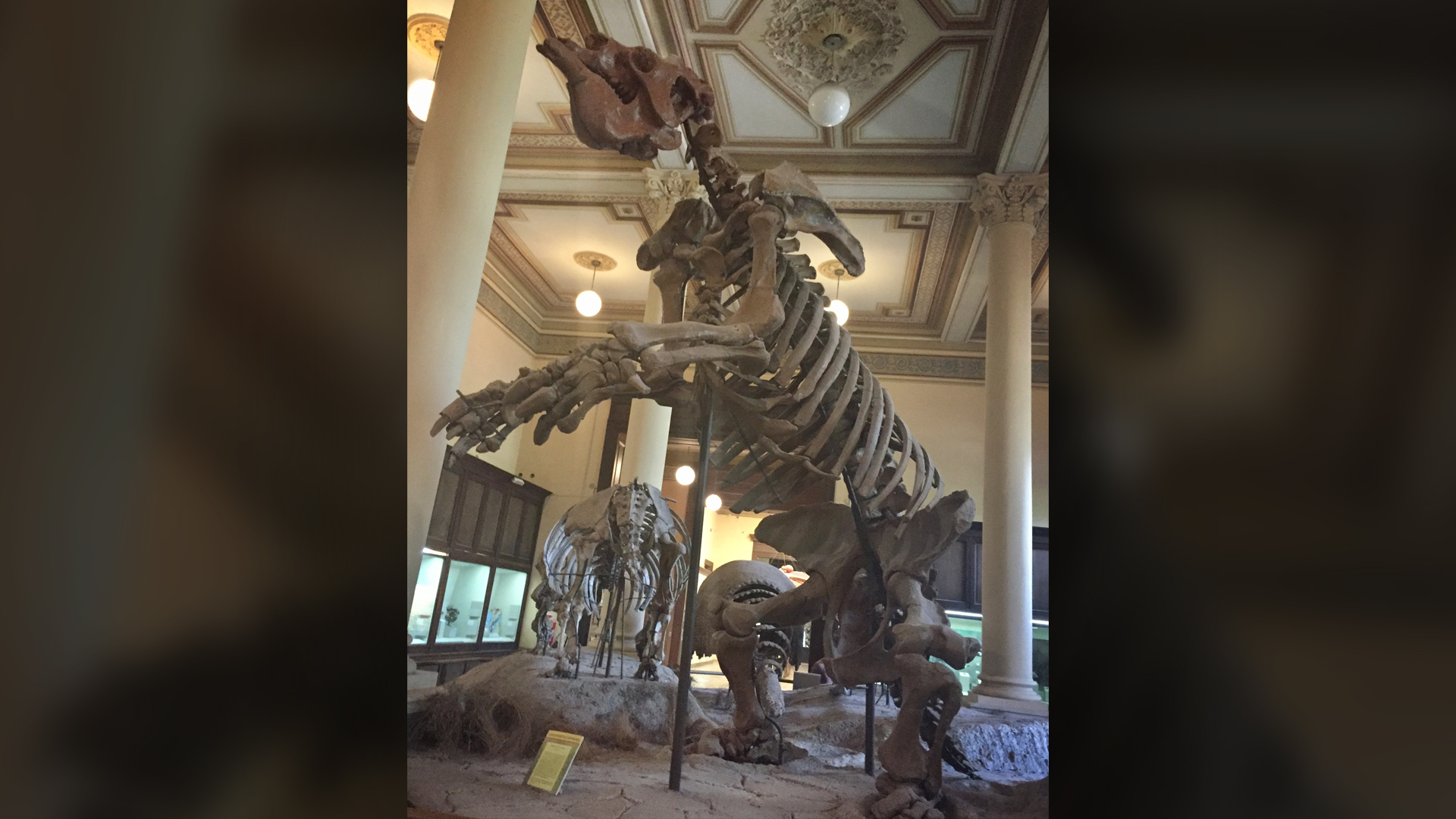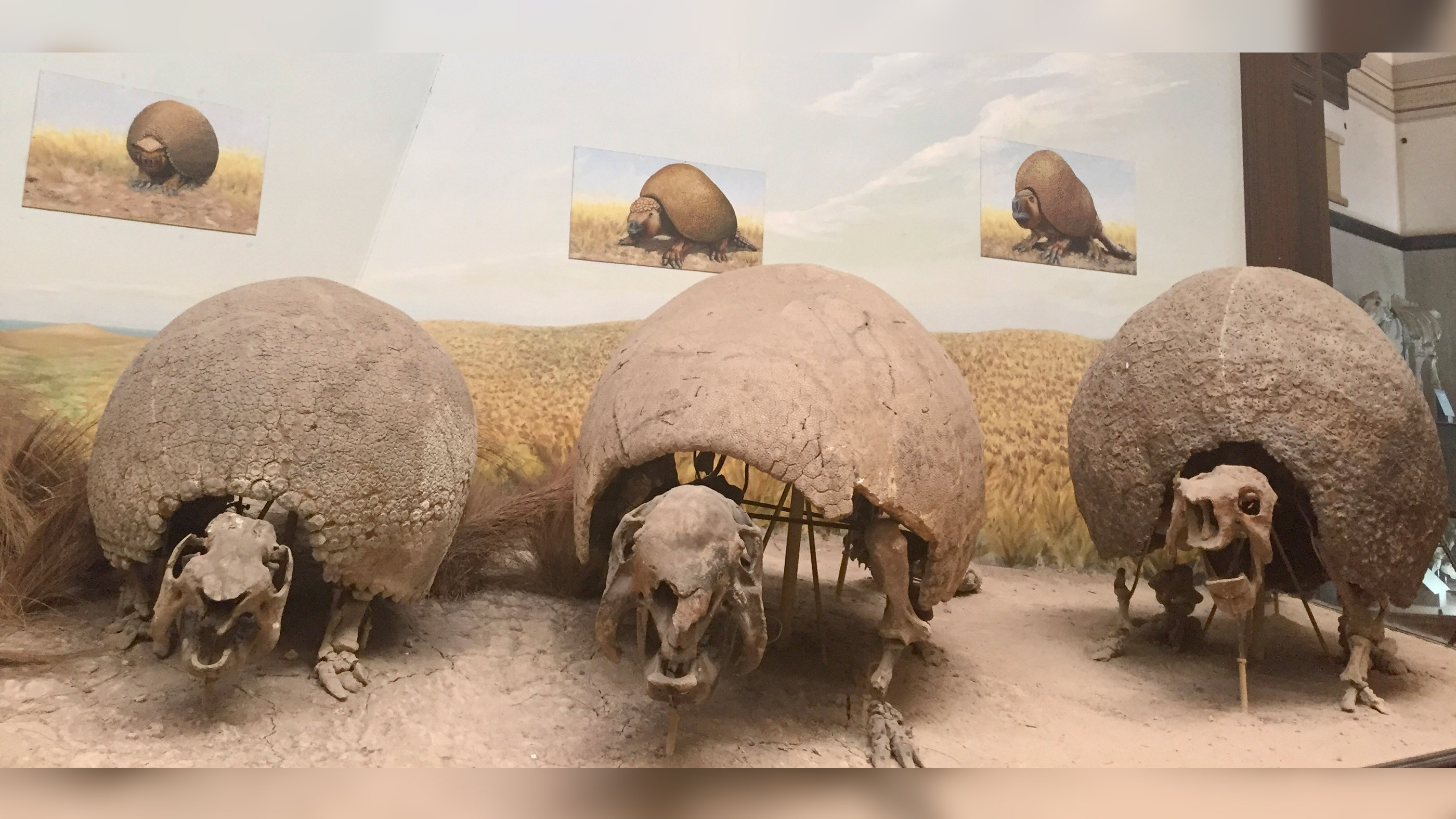When Were People Born And What Animal
What'due south the first species humans drove to extinction?

One-time in the late 1600s, in the lush forests of Mauritius, the very last dodo took its concluding breath. Subsequently centuries of untroubled ferreting in the tropical undergrowth, this species met its untimely stop at the hands of humans, who had arrived on the island less than 100 years before. With their penchant for hunting, habitat destruction and the release of invasive species, humans undid millions of years of evolution, and swiftly removed this bird from the face of the Earth.
Since so, the dodo has nestled itself in our conscience as the beginning prominent example of human-driven extinction. We've also used the dodo to assuage our own guilt: the fauna was fat, lazy and unintelligent — and as pop story goes, those traits sealed its inevitable fate.
But in fact, we couldn't be more wrong, said Julian Hume, a paleontologist and inquiry acquaintance with the National History Museum in the United Kingdom. He studies the fossils of extinct species, and has devoted a portion of his career to correcting the dodo's dismal reputation. By digitally modelling the remains of a dodo's skeleton, he's produced a 3D digital reconstruction that draws an altogether different picture of a bird that was faster, more athletic and far brainier than popular culture has led us to believe. "It was nothing like this big, fat, bulgy thing that was merely waddling around. This bird was super adapted to the environs of Mauritius," Hume told Live Science. Instead, humans' unrelenting exploitation was the existent culprit behind the dodo's untimely death.
Related: What could drive humans to extinction?
Simply that's not all we've gotten wrong. Despite the normally held belief, the dodo really wasn't the first creature that humans collection to extinction — non by a long shot. In fact, humanity was wiping out the earth'due south fauna thousands of years before we gear up eyes on the dodo. "There was certainly a lot more than going on earlier and after that event," said Hume.
And then, if the iconic dullard wasn't the outset species we drove to the brink, then which animal gets this disheartening title, instead?
Humans on the move
We've grown accustomed to thinking about human-driven species extinction equally a relatively recent trend in our history. However, researchers accept institute convincing palaeontological bear witness that dismantles that idea.
"The real problem started when we, as humans, started migrating," Hume said. That starting point is still debated, but most recent estimates suggest that migrations that led to lasting populations of humans spread across the world began with the movement of hominids — Neanderthals and other aboriginal homo relatives, as well Homo sapiens — out of Africa and southeast Asia, roughly 125,000 years ago. This is where the bear witness gets interesting. As humans left their bequeathed homes, and over the following tens of thousands of years went on to colonize Eurasia, Oceania, North and Due south America, the fossil tape shows a parallel uptick in the extinction in large-bodied animals — also known every bit megafauna — across those continents.
"As [hominids] migrated out of Africa, you meet this incredibly regular pattern of extinction," said Felisa Smith, a professor of environmental and evolutionary biology at the University of New Mexico, who studies how animals' body sizes take changed over the course of history. As she and her colleagues explained in a 2018 written report published in the journal Scientific discipline, each time our ancestors set foot in new places, fossil records show that large-bodied species — the humongous prehistoric relatives of elephants, bears, antelope and other creatures — started going extinct within a few hundred to one,000 years, at most. Such rapid extinction timescales don't occur at any other point in the concluding several one thousand thousand years (non since the non-avian dinosaurs were wiped out by an asteroid almost 65 million years agone.) "The only fourth dimension y'all see it is when humans are involved, which is really hitting," Smith said.

Some of those early on lost species would seem like fantastical beasts if they roamed Globe today. For example, "There was an armadillo-similar thing called the glyptodon, which was the size of a Volkswagen bus," Smith told Live Scientific discipline. Glyptodons, many equipped with vicious-looking spiked tails, disappeared from the Americas at the end of the terminal water ice age, roughly 12,000 years ago — which is probably connected to the earlier arrival of humans there. The number of gigantic Eurasian cave bears, several hundred pounds heavier than grizzly bears today, went into a steep refuse near 40,000 years ago (opens in new tab), around the aforementioned time that humans began to spread across their habitat. Southward America was in one case home to lumbering behemothic ground sloths — and humans were also the most probable candidate in their demise, about eleven,000 years agone.
Related: How oft do ice ages happen?

What fabricated large animals, in particular, so susceptible to humanity's spread? Megafauna likely represented nutrient, or a threat, to incoming humans. What's more than, animals that had never encountered humans earlier were probably unwary of these foreign newcomers migrating into their unspoiled lands, which might take increased their vulnerability to assault. Unlike other smaller animals that breed more than speedily, megafauna too reproduce more than slowly and so have smaller populations compared with other species, Hume explained: "And so if you accept out a big section of [a population] they cannot reproduce chop-chop enough to build up numbers over again."
It wasn't just hunting that posed a threat — but also the spread of human-acquired fires that would have destroyed swathes of habitat, and increasing competition from humans for nutrient. For instance, it's thought that by preying heavily on the same herbivores, growing numbers of hungry humans helped drive the extinction of the brusque-faced bear, a gigantic South American species that one time stood at over 10 anxiety (3 meters) alpine, and died out roughly 11,000 years ago. Climate change, paired with human impacts like hunting, likewise proved to be a lethal combination for some megafauna — most famously, mammoths, which went extinct near 10,500 years ago (except for the dwarf woolly mammoth, which survived until about 4,000 years ago on an island off northern Russia). "If you combine climatic change with a negative human impact, information technology's a disaster," said Hume.

An answer?
All of this is to say that humans accept systematically wiped out the species around us from almost the beginning of our history. Our migration prompted "a disaster across the world," said Hume. "We weren't very pleasant." Unfortunately, nosotros've connected our ancestors' legacy, with, among thousands of other species, the eradication of Madagascan hippos 1,000 years ago, the loss of moa birds in New Zealand 600 years ago, and the decimation of passenger pigeons 106 years ago. We are also responsible for ongoing extinctions today.
But this still hasn't answered the question of what species went extinct first. And here'due south the catch: the data on man-driven extinction across the planet is only reliable as far dorsum as virtually 125,000 years— only that doesn't mean we weren't driving animals to extinction before that in Africa, too. In fact, there's compelling testify to suggest that before humans migrated out, they unleashed their hunting instincts on species at that place too.
Related: When did humans discover how to employ fire?
Smith's inquiry has revealed that the boilerplate body size of African animals 125,000 years ago was but half that of species that were present on other continents effectually the world. "Africa is one of the largest continents, and then it should have had a mean body size similar to that of the Americas and Eurasia where it was roughly about 100 kilograms [220 lbs.]," Smith said. "The fact that information technology didn't suggests that there had already been an effect of hominids on megafauna in Africa, prior to 125,000 years agone."
In essence, because the rest of history tells usa that humans are good at dispatching the largest creatures in an ecosystem, we can brand a adequately safe assumption that hominids in Africa at the time could have been responsible for extinctions going even further back in time.
Still, there'south no way to know for sure what that 'get-go' species would have been — though Smith takes a wild guess: "It was probably some species in the elephant family. But whether that's palaeomastodon, or stegodon" — the latter existence a behemoth with tusks that measured 10 feet (3 meters) long - "I couldn't tell y'all."
Clues for the future
Nosotros may not have a clear reply to that original question - merely perhaps the more important 1 to inquire is what humanity'due south legacy of extinction can teach u.s.a. about conservation, going into the future.
By extinctions take revealed that when animals — peculiarly megafauna — disappear, at that place are profound ecological consequences. Whole landscapes are transformed in the absence of their shaping effects, with changes to vegetation and species multifariousness. Smith has even published enquiry showing that the decline of global megafauna in past millennia led to dips in the amount of methane they burped out — with potentially transformative consequences for global climate. What's more, when animals disappear, whole rafts of dependent species become down with them. The iconic dullard presents one such cautionary tale: when the birds died out, and then did a Mauritian dung protrude that relied on dodo feces to survive.
Agreement homo-driven extinctions of the past can assist the states figure out what the environmental consequences have been, explained Smith, and how we can limit those in the time to come by protecting the species that remain. Even the dodo'due south extinction provides clues that are helping united states preserve ecosystems today. Hume is working on a projection to catalog pollen spores present in the sediments around dodo fossils, to build upwards a detailed picture of the lush, palm-fringed forests they in one case roamed. That's helping conservationists to rewild the island with vegetation that was once there. "We're really reconstructing the exact species of plants and trees from the environment the dodo was living in, before humans arrived," Hume said.
A scrap of paradise was lost when we drove the dodo to extinction — non to mention the thousands of species whose demise came before that. Only perhaps with hindsight, and the willingness to acquire from our mistakes, some of that can be reclaimed.
Originally published on Live Science.
Source: https://www.livescience.com/first-human-caused-animal-extinction.html
Posted by: moradoyoulty.blogspot.com

0 Response to "When Were People Born And What Animal"
Post a Comment